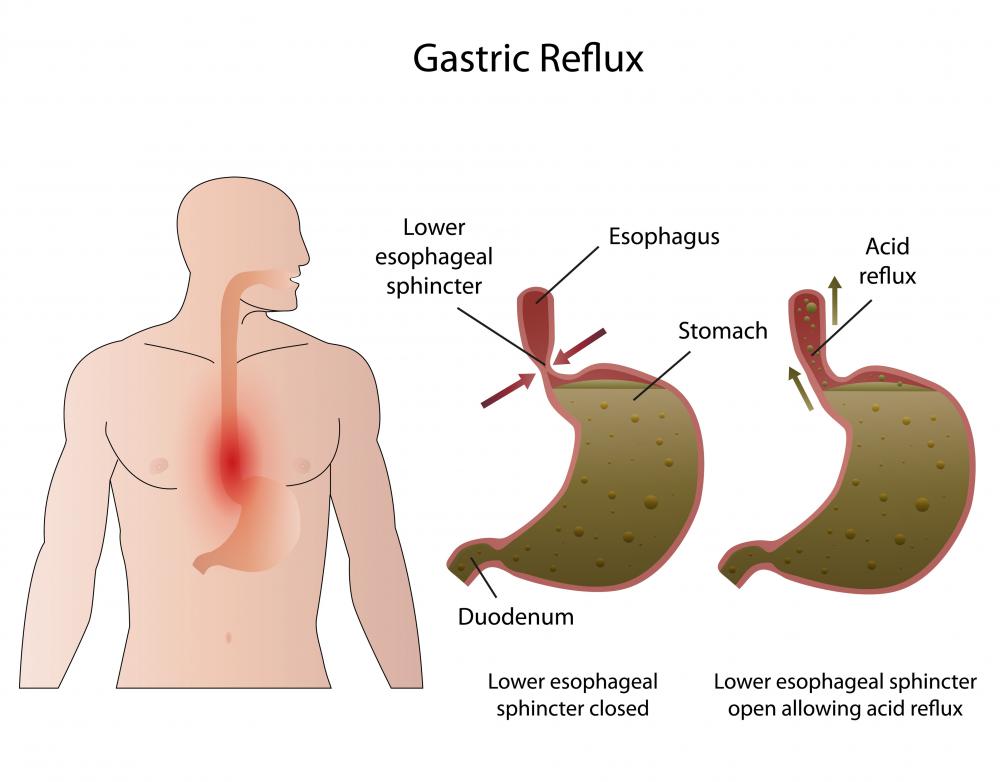At WiseGEEK, we're committed to delivering accurate, trustworthy information. Our expert-authored content is rigorously fact-checked and sourced from credible authorities. Discover how we uphold the highest standards in providing you with reliable knowledge.
What is a Dysphagia Diet?
A dysphagia diet is used to treat dysphagia, a condition in which the patient has difficulty chewing and swallowing. Patients with this condition require a specialized diet because they have trouble eating normal foods, and therefore receiving proper nutrition. This type of diet has different levels designed to help the patient progress from liquids to more solid foods over time.
There are two main types of dysphagia: esophageal and oropharyngeal. In esophageal dysphagia, digested material stops moving in the esophagus, the tube leading from the throat to the stomach. This may be due to acid reflux, the back up of stomach acid into the esophagus, causing inflammation and constriction of the esophagus. Esophageal dysphagia causes a burning sensation in the chest.

Oropharyngeal dysphagia is a difficulty moving food to the back of the throat and swallowing. It can be caused by nervous system disorders, such as cerebral palsy and Alzheimer's disease, dental disorders, psychological illness, neck injury, or cancer of the throat or neck. Symptoms include drooling, coughing, and choking during meals, pocketing food in the cheeks, weight loss, and chronic respiratory infection. Food may also back up into the nasal passages. It is important to correctly diagnose the cause of oropharyngeal dysphagia before treating the condition.

A dysphagia diet typically starts with liquids, since patients may find it easier to swallow thickened liquids. When following this type of diet, the patient should take care to eat slowly, take small bites, maintain an upright posture, and refrain from talking while eating. One of the major concerns is making sure that the patient is consuming enough calories. Foods can be fortified with powdered milk, fruit juice, honey, sugar, jelly, margarine, or pureed baby food to increase their caloric content.

The first level of a dysphagia diet is pureed foods. The food should have a smooth, uniform consistency to make swallowing easier. Next, the patient can progress to minced foods. The individual pieces of food in this stage should be very small, about the size of sesame seeds.
The third level is ground foods, with individual food pieces similar in size to rice, while the fourth is chopped foods, in pieces about the size of croutons. If the patient can comfortably eat foods in this stage, he or she can progress to normal foods, but should stick to foods of a moist, soft, and regular consistency. Depending upon the severity of a patient's dysphagia, he or she may not need to begin at the first level. Whatever level a patient can eat and swallow comfortably at is an appropriate starting level.
AS FEATURED ON:
AS FEATURED ON:















Discussion Comments
My mom has Parkinson's and has to have all of her food pureed. Her diet is very balanced. I have mastered the are to turning a regular plate of food into pureed creations. Shes loves it! She eats better than I have seen her eat in a long time. I try to stay away from the carbs since she is bedridden, but she eats tons of veggies, fish and turkey. She has bed exercises daily and is doing great. The key is to make it taste good, even though its served in a spoon. --Kimberley
Metamucil is in powdered form and can be added to anything for more fiber.
@googlefanz -- You're right, there are diet societies and things like that for people with dysphagia, but there are a surprising amount of recipes on the internet as well.
A lot of my patients start out on a basic clear liquid diet, and then move up to a bland soft diet as they become better at tolerating the feel of the liquid.
Many people with dysphagia also order their meals off the internet. There are a ton of sites that sell nutritionally balanced, premixed meals as well as things like food thickeners, and even specially designed cups and utensils for learning to eat with dysphagia.
In terms of the personal nutritional advice you mentioned, most doctors who diagnose a patient with dysphagia also refer them to a nutritionist or dietitian to help them design their new diet. Besides, many people with dysphagia are already in care, so they don't have to worry so much about their own diet anyway.
Great questions though!
How can a person on a diet like that get all the calories they need? Or fiber, for that matter? Even if you do add in baby food to the pureed diet, then you still wouldn't get enough fiber.
How do people in dysphagia advanced diets deal with that? I'm sure there's some kind of National Dysphagia Diet Society or something, but where can people with this condition get personal nutritional advice?
I've never had anything like this, so this is all new territory to me, but I'd love to hear about some other peoples' experiences with this -- it sounds like such a hard thing to do.
I had a cousin who had to go on a soft, no acid diet for dysphagia a few years ago, and let me tell you, it gets old really fast.
Although it's kind of nice to think about just having smoothies all day, you really can't subsist on ice cream and fruit smoothies, so you have to mix in some other things that aren't really smoothie friendly.
Of course, it's gotten a lot easier now with all the protein powders and whatnot, but still, even the whole act of not being able to chew can kind of wear on you.
If you're having to follow a liquid diet like this, believe me, I sympathize with you!
Post your comments